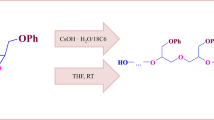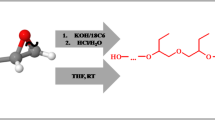Abstract
In this study microwave-assisted anionic ring opening polymerization (ROP) of alkylene oxides is reported. Low molar mass polymers of propylene oxide (PO), butylene oxide (BO) and hexylene oxide (HO) are synthesized by anionic ring opening using various monohydric alcohols as initiators. The monohydric alcohols and lower molar masses allowed for monitoring of different types of possible unwanted by-products and their sources. Liquid chromatography at critical conditions (LCCC) and liquid adsorption chromatography (LAC) are used to determine the presence of oligomers other than targeted. Finally, MALDI-TOF MS of the products have clearly shown the trends and extents of different types of side reactions that are possible in anionic ring opening of alkylene oxides. Propylene oxide is most vulnerable to chain transfer reactions compared to higher alkylene oxide.









Similar content being viewed by others
References
Hamley IW (2005) Block copolymers in solution: fundamentals and applications. John Wiley & Sons, Ltd, Chichester
Hamley IW (2004) Developments in block copolymer science and technology. John Wiley & Sons, Sussex. doi:10.1002/0470093943
Pitto-Barry A, Barry NPE (2014) Pluronic® block-copolymers in medicine: from chemical and biological versatility to rationalisation and clinical advances. Polym Chem 5(10):3291–3297. doi:10.1039/c4py00039k
Quirk RP, Ge Q (2000) Anionic synthesis and characterization of poly(styrene-block-1-butene oxide) block copolymers and their application in anionic dispersion polymerization. Polym Prepr (Am Chem Soc Div Polym Chem) 41(2):1221–1222
Allgaier J, Willbold S, Chang TH (2007) Synthesis of hydrophobic poly(alkylene oxide)s and amphiphilic poly(alkylene oxide) block copolymers. Macromolecules 40(3):518–525. doi:10.1021/ma062417g
Dulle M, Malik MI, Trathnigg B, Glatter O (2010) Self-assembly and structural analysis of multiblock poly(oxyalkylene) copolymers. Macromolecules 43(18):7868–7871. doi:10.1021/ma101384r
Bailey FE, Koleske JV (1991) Polymerization of 1,2-epoxides. In: Schick MJ, Frederick MF (eds) Alkylene oxides and their polymers, surfactant science series, vol 35. Marcel Dekker, New York, pp 35–103
Simons DM, Verbanc JJ (1960) The polymerization of propylene oxide. J Polym Sci 44:303–311
Becker H, Wagner G, Stolarzewicz A (1982) Chain transfer reaction in the anionic polymerization of oxiranes. III. Dynamics of double bond formation in the polymerization of propylene oxide. Acta Polym 33(1):34–37
Yu G-E, Masters AJ, Heatley F, Booth C, Blease TG (1994) Anionic polymerization of propylene oxide. Investigation of double-bond and head-to-head content by NMR spectroscopy. Macromol Chem Phys 195(5):1517–1538. doi:10.1002/macp.1994.021950506
Gallet G, Carroccio S, Rizzarelli P, Karlsson S (2002) Thermal degradation of poly(ethylene oxide-propylene oxide-ethylene oxide) triblock copolymer: comparative study by SEC/NMR, SEC/MALDI-TOF-MS and SPME/GC-MS. Polymer 43(4):1081–1094. doi:10.1016/S0032-3861(01)00677-2
Malik MI, Trathnigg B, Kappe CO (2008) Microwave assisted synthesis and characterization of end functionalized poly(propylene oxide) as model compounds. Eur Polym J 44(1):144–154. doi:10.1016/j.eurpolymj.2007.10.025
Malik MI, Trathnigg B, Kappe CO (2007) Selectivity of PEO-block-PPO diblock copolymers in the microwave-accelerated, anionic ring-opening polymerization of propylene oxide with PEG as initiator. Macromol Chem Phys 208(23):2510–2524. doi:10.1002/macp.200700320
Quirk RP, Ge Q (2000) Anionic polymerization chemistry of 1-butene oxide: Functionalization and block copolymerization. In: 219th ACS National Meeting, San Francisco, CA, March 26-30. pp OLY-023
Kim I, Yi MJ, Byun SH, Park DW, Kim BU, Ha CS (2005) Biodegradable polycarbonate synthesis by copolymerization of carbon dioxide with epoxides using a heterogeneous zinc complex. Macromol Symp 224:181–191. doi:10.1002/masy.200550616
Malik MI, Trathnigg B (2009) Full separation of oligomers in block copolymers of ethylene oxide and propylene oxide. J Sep Sci 32(11):1771–1781. doi:10.1002/jssc.200900043
Malik MI, Trathnigg B, Kappe CO (2009) Microwave-assisted polymerization of higher alkylene oxides. Eur Polym J 45(3):899–910. doi:10.1016/j.eurpolymj.2008.11.035
Malik MI, Lee S, Chang T (2016) Comprehensive two-dimensional liquid chromatographic analysis of poloxamers. J Chromatogr A 1442:33–41. doi:10.1016/j.chroma.2016.03.008
Yu G-E, Heatley F, Booth C, Blease TG (1994) Anionic polymerization of propylene oxide: isomerization of allyl ether to propenyl ether end groups. J Polym Sci A Polym Chem 32(6):1131–1135. doi:10.1002/pola.1994.080320615
Malik MI, Pasch H (2014) Novel developments in the multidimensional characterization of segmented copolymers. Prog Polym Sci 39(1):87–123. doi:10.1016/j.progpolymsci.2013.10.005
Pasch H, Trathnigg B (2013) Multidimensional HPLC of polymers. Springer, Berlin-Heidelberg. doi:10.1007/978-3-642-36080-0
Malik MI, Trathnigg B, Bartl K, Saf R (2010) Characterization of polyoxyalkylene block copolymers by combination of different chromatographic techniques and MALDI-TOF-MS. Anal Chim Acta 658(2):217–224. doi:10.1016/j.aca.2009.11.017
Malik MI, Trathnigg B, Kappe CO (2009) Amphiphilic polymers based on higher alkylene oxides. Synthesis and characterization by different chromatographic techniques. J Chromatogr A 1216(7):1167–1173. doi:10.1016/j.chroma.2008.12.067
Malik MI, Trathnigg B, Saf R (2009) Characterization of ethylene oxide-propylene oxide block copolymers by combination of different chromatographic techniques and matrix-assisted laser desorption ionization time-of-flight mass spectroscopy. J Chromatogr A 1216(38):6627–6635. doi:10.1016/j.chroma.2009.07.067
Malik MI, Ahmed H, Trathnigg B (2009) Liquid chromatography under critical conditions (LCCC): Practical applications in the analysis of amphiphilic polymers. Anal Bioanal Chem 393(6-7):1797–1804. doi:10.1007/s00216-008-2590-y
Author information
Authors and Affiliations
Corresponding author
Rights and permissions
About this article
Cite this article
Malik, M.I., Irfan, M., Khan, A. et al. Alkylene oxide poylmerizations: identification of side reactions and by-products. J Polym Res 23, 258 (2016). https://doi.org/10.1007/s10965-016-1141-z
Received:
Accepted:
Published:
DOI: https://doi.org/10.1007/s10965-016-1141-z




